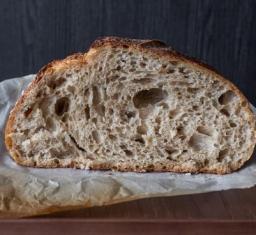Oh well...
After reading so much about people's love of the Thom Leonard country French bread, I decided to try it, following the steps in mountaindog's post. Here's the breakdown:
Starter: Early Thursday, I began the rye starter with a generous teaspoon of my active white starter, 1 T. dark rye and 1 T water; fed it the same rye and water amounts almost 6 hours later - had good bubbles at that point. Just before bed, discarded half of it, and fed same amounts again. Friday at about 6:45 a.m., I fed it 50g each of rye and water, without dumping anything. It doubled in 3 hours and was very bubbly!

Levain: I mixed the levain at 7:00 p.m. Friday. The starter had not moved up or down, and I wonder if I should have feed it once more; the instructions say you can feed the starter up to 12 hours before mixing the levain, so I thought I was in the ballpark. Next morning, Saturday, the levain looked like this at about 6:40 a.m. (no such thing as sleeping in with a toddler in the house):

OK, looks good! I began mixing the dough around 7:00. I added no extra flour to knead, which I did for 10 minutes, then 5 more minutes after adding the salt. The dough was pretty firm, not sticky at all. I think mountaindog said it felt like piecrust dough to her, and I agree. Rested the dough for 30 minutes, then did the 3 S&F cycles with 30 minutes between each. The dough was easy to stretch out, but it felt like nothing much was happening until the 3rd cycle, when it began to feel like there was some growth going on. Then it sat in the bowl for the remaining 90 minutes, at about 69F.
Resting and Shaping: I divided the dough into 2 balls, and rested them for 15 minutes, then further shaped into boules and set them on parchment to proof (I don't have bannetons), on a baking stone. Heard plenty of bubbles popping as I tried to gently increase the tension.
Proofing: OK, here's where I deviated a little (busted!). I wanted to make sure the bread was baked before we went to a friend's house for dinner (pizza, go figure). So I used the proofing cycle in my oven, set to 85F. Covered the dough with oiled plastic, and set timers to check once an hour. After two hours, a small tragedy began to unfold:

The dough had outgrown the stone; it felt nice and light, though. The top one in the picture is mangled because I had started to try to rescue it, then (in true Fresh Loaf fashion) thought to grab the camera for posterity. At first, I had dough damage panic, then I started to chuckle sort of oddly, and thought "Wait, I really meant to make oblong loaves...yes, that's right! Oblong!"

...show's over, go on about yer business, folks...back in the warm oven they went for another hour (3 hours total proof).
Bake: Since mountaindog has posted about baking this bread from a cold start, I did that too. Set the oven to 425F and made some of the ugliest slashes I've done recently...too ugly to photograph in the raw. Here's how it all turned out:

They rose, and they look edible, but in a sorta grocery-store-ish way. Well, let's see what's inside, shall we?
Aw, RATS!

The holes were left on the cutting room floor! Though I think that any degassing during the reshaping didn't affect the interior of the loaves; I don't think the crumb would have been open even if the boules had proofed fully untouched. The flavor is mild and it's quite edible, with a slight tangy aftertaste, but I was disheartened at this result. Sounds pretty civilized, eh? Actually, I pouted a bit and exercised my vocabulary, if you know what I mean.
So I'd like to ask the Leonard veterans if anything I described in the procedure sounds like the culprit...other than extreme dough-handling mid-proof. Maybe that's the only problem, who knows?
Now I'm off to go check on TT and JMonkey's starter escapades...
Sue





